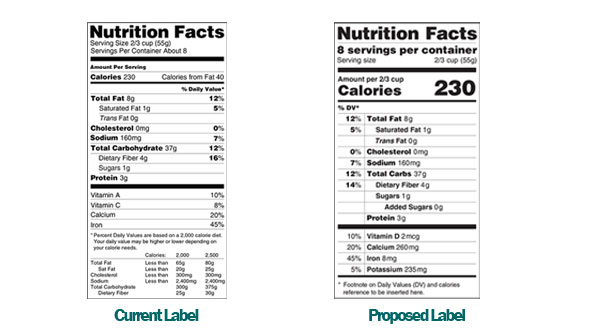The Food and Drug Administration has officially released a proposal to change the Nutrition Facts panel on packaged foods. With a more prominent display of calorie counts, more realistic serving sizes and new requirements about disclosure of added sugar content, the label overhaul aims to guide Americans toward healthier food choices.
February 27, 2014

Changes are afoot for the long-standing Nutrition Facts panel that graces packaged foods nationwide. On Feb. 27, the Food and Drug Administration filed an official proposal for the first major overhaul of the nutrition label in the more than 20 years since it became a requirement for all packaged foods. The proposal’s focus on serving sizes, added sugars and nutrients like vitamin D and potassium reflects the recognition of the drastic changes that have occurred in the American diet and represents an effort to halt the rapid development of serious chronic diseases connected to the way we eat.
Calorie count, serving size and Percent Daily Value (which will also see some changes) will get more prominent play on the newly proposed label and a two-column format will show both per-serving and per-package calorie and nutrition information on products that people could eat all in one sitting (we can all remember inadvertently eating the entire bag of chips at least once right?). Serving sizes will more accurately reflect how much Americans actually eat, not what they should be eating. Ice cream labels, for example, will change to a one cup serving size, while the serving size on a soda will be 20 ounces or 12 ounces instead of the usual 8 ounces. Labels will also be required to include the amount of sugar added to the product by the manufacturer in addition to the amount of naturally occurring sugar in the food, a change that elicited pushback from some industry groups including the Grocery Manufacturers Association.
On the other side, the Center for Science in the Public Interest is recommending that the new nutrition label go one step further and include a daily value for added sugars. That extra information could do even more to encourage people to choose healthier options without added sugars, said Rachel Begun, MS, RDN, a food and nutrition expert and consultant to the food industry. "With the current proposed change, a person can now identify how much added sugars are in their foods, but that doesn't mean that they know what their daily limit should be and how much a specific food contributes to their daily limit," Begun said.
The FDA's label proposal also better aligns with 2010 Dietary Guidelines for Americans that identifies fiber, potassium, calcium and vitamin D as the nutrients most likely to be missing from Americans' diets, Begun said. Instead of declaring the amount of vitamins A and C in a product, manufacturers will be required to state the amount of vitamin D, important for bone health, and potassium, crucial for regulating blood pressure, on nutrition labels. Total fat, saturated fat and trans fat will continue to show up on labels, but “calories from fat” would be removed, reflecting research that the type of fat in Americans’ diets is more important than the amount.
Public health advocates generally support the proposal as a much-needed step to steer people toward healthier eating habits.
"Our guiding principle here is very simple: that you as a parent and a consumer should be able to walk into your local grocery store, pick up an item off the shelf, and be able to tell whether it’s good for your family,” Michelle Obama said in a statement. “So this is a big deal, and it’s going to make a big difference for families all across this country.”
Don’t hold your breath for immediate change though—the proposal now enters a 90-day public comment period after which the FDA will issue a final rule. Manufacturing companies will then have two years to implement the changes on product packaging.
Visit the FDA's website to view the full proposal as well as more information on the proposed change.
About the Author(s)
You May Also Like




